|
|
|
Sort Order |
|
|
|
Items / Page
|
|
|
|
|
|
|
| Srl | Item |
| 1 |
ID:
172224
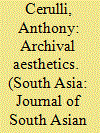

|
|
|
|
|
| Summary/Abstract |
Can the Indian manuscript and manuscript library be art? In what follows, I reflect on this question by examining a set of photographs I created for an art project called Manuscriptistan. I explain what it has meant for me to aestheticise Indian manuscript libraries and manuscripts, and I offer some insights about why it is important for scholars to bring sensual, spatial and artistic awareness to the things with which, and the spaces in which, they do their research.
|
|
|
|
|
|
|
|
|
|
|
|
|
|
|
|
| 2 |
ID:
172229
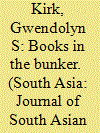

|
|
|
|
|
| Summary/Abstract |
Under United States Public Law 480, a major hallmark of Cold War diplomacy, India received millions of dollars in loans from the US during the 1950s and 1960s in the form of food and agricultural products. A portion of the interest due on this loan was repaid by India partly in the form of books in about two dozen languages which were collected from across South Asia and sent to the Library of Congress and several universities in the country during the heyday of the development of Area Studies. The object of this paper is a large deposit of written material—books, periodicals and ephemera—that was sent to the University of Texas at Austin over a period starting in the 1960s under the PL 480 programme. Most of these materials were added to the library collections, but a large number of them remained uncatalogued for about fifty years in an underground library storage facility in downtown Austin. The history of these materials, and the moment when they reappeared provides a case study of how books are appropriated (or not) into academic, library and political assemblages, and the way disciplines and their canons have been shaped by politics and infrastructure from the Cold War into the neo-liberal age.
|
|
|
|
|
|
|
|
|
|
|
|
|
|
|
|
| 3 |
ID:
172226
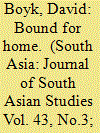

|
|
|
|
|
| Summary/Abstract |
At the turn of the twentieth century, a group of young men in Desna, a qasba (small town) in Bihar, founded an organisation called the Anjuman Al-Islah. There they shared their books in the name of promoting education and cultivation, which they saw as ‘paramount in life’s every undertaking’ and essential to the defence of qasbati culture. Through sustained collaborative efforts, the Anjuman soon built up an impressive library of Urdu books and periodicals. Where other libraries were assembled at the initiative of aristocratic patrons or government officials, the Al-Islah library relied on the contributions of numerous Desnavis, both those who still lived in the qasba and those whose careers had taken them far away. In turn, the Anjuman and its library nurtured Desnavis’ ties to each other and to their watan, or homeland.
|
|
|
|
|
|
|
|
|
|
|
|
|
|
|
|
| 4 |
ID:
172222
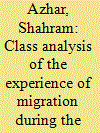

|
|
|
|
|
| Summary/Abstract |
Abstract
The paper conducts a class analysis of the human experience of migration during the Partition of India using a dataset constructed from 1,000 recently published oral narratives by migrants from across the Indian subcontinent. The dataset collates and maps information for four key variables: (1) origins and destinations of migrants; (2) class backgrounds of migrants; (3) modes of transport used during migration; and (4) experiences of direct or indirect violence. Satellite mapping and network analysis are used to develop an empirically grounded cartographic understanding of the relationships between these variables. The results point to a sharply hierarchical story. Differences in class background not only closely correlate with differences in mode of transport and choice of destination, but also with the timing and intensity of an episode of violence. Most importantly, migrants’ experiences show greater similarity within class background and regionality than within a religious group. Thus, not only are discussions based on the conceptual binary of religion unable to account for the large variations in the experiential aspects of Partition, they are also unable to connect these experiences to the broader social structure of the colonial polity in the Indian subcontinent. By reinstating class as an analytical category, this paper seeks to improve our understanding of the humanitarian costs and consequences of the Partition of 1947.
|
|
|
|
|
|
|
|
|
|
|
|
|
|
|
|
| 5 |
ID:
172220
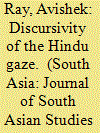

|
|
|
|
|
| Summary/Abstract |
The ‘travelogue’ as a genre in late nineteenth-century India is intrinsically linked with colonial exposure, literary modernity and the ethos of a nascent Indian nationalism. This paper uses Bholanauth Chunder’s The Travels of a Hindoo to Various Parts of Bengal and Upper India (1869) as a case study to illustrate how travelling practices in colonial India were, among other things, aimed at achieving cultural proximity with the coloniser. It examines how the relationship between the traveller (Chunder) and the ‘travelled’ was mediated by heuristic categories emerging out of Western imperialism, particularly the conceptual category of ‘Hindoo’, that were being fervently invoked in the nineteenth century. I argue that Chunder’s ‘Hindoo’ gaze fostered a communal ethos at a time when cultural histories were being woven from a highly contingent process of political partisanship amid struggles over the meaning of nationhood and citizenship, interacting with (anti-)imperialist ideologies laced with notions of territorialisation.
|
|
|
|
|
|
|
|
|
|
|
|
|
|
|
|
| 6 |
ID:
172230
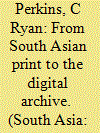

|
|
|
|
|
| Summary/Abstract |
This essay examines the challenges involving the creation of and access to digital content and those faced by smaller nineteenth-century publishers in South Asia. Rather than seeing the digital arena of online publishing as representing a break with preceding periods and technologies, this article argues that, as during the period of print’s expansion in colonial India towards the end of the nineteenth century, the digital arena is at its core an ongoing experiment in which legislation and regulations, readers, publishers, libraries, pirates and business interests continue to play off one another in a metaphorical dance through which the digital publishing landscape is created. For those in late colonial India who sought to enter the world of print and for contemporary efforts to make digitised materials available online alike, the quest for fiscal sustainability has been one of the greatest challenges. By combining an examination of the Urdu writer Abdul Ḥalīm Sharar’s (1860–1926) struggles in publishing the monthly periodical, Dil Gudāz, between 1887 and 1934 with the challenges faced by online archives today, this essay teases out parallels and differences. I argue that the ability of smaller presses to thrive in India in the late nineteenth and early twentieth centuries was dependent on a responsive public that accepted its newfound role as patrons, whereas in the present, private donations and grants are the crucial ingredients that can help ensure collaborations achieve their goals.
|
|
|
|
|
|
|
|
|
|
|
|
|
|
|
|
| 7 |
ID:
172228


|
|
|
|
|
| Summary/Abstract |
This article focuses on the Hindi Sahitya Sammelan, founded under the aegis of the Nagari Pracharini Sabha in 1910 in Allahabad, and its active bid to establish what can be seen as the first archive of, and in, Hindi. While the Sammelan’s library functioned as a public-facing, community-serving space that housed and issued printed books, periodicals and newspapers in its reading room, the archive was imagined as an accumulation of all materials, print and manuscript, relating to Hindi, with access limited to critics and scholars. The article argues that infrastructure like the library and the archive critically contributed to the process of consolidation and legitimisation of the discourse on Hindi nationalism. It also traces the post-Independence assimilation of this library to the machinery of state bureaucracy, specifically to the institution of the Uttar Pradesh Hindi Sahitya Sammelan Act, 1956, and the central government’s Hindi Sahitya Sammelan Act, 1962, which declared the Sammelan ‘an institution of national importance’. How do these acts reflect tensions between the politicisation of Hindi as the national language and democratisation in post-colonial India? Here, the article shows that Hindi was not only being monetarily patronised in the 1950s and 1960s, but was also vigilantly monitored, drawing staunch resistance from the Sammelan, which saw itself as a moral alternative to the state. It traces the history of these legislative processes which ultimately resulted in a petition against the 1962 Act in the Supreme Court in 1973, which declared it invalid.
|
|
|
|
|
|
|
|
|
|
|
|
|
|
|
|
| 8 |
ID:
172223
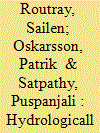

|
|
|
|
|
| Summary/Abstract |
This article analyses how long-running, multilayered conflicts over water at the Hirakud dam underpin present-day societal divisions in Odisha state. There are four unresolved conflicts over this dam in the state: movements against displacement, movements for rehabilitation, struggles between agricultural and industrial water users, and, finally, disputes between federal states. These have generated societal ruptures from the announcement of the dam in 1946 to the present day. We argue that understanding the confluence and ingrained, overlapping character of these conflicts provide important vantage points for understanding the present uneasy constitution of subregional state fabrication in Odisha.
|
|
|
|
|
|
|
|
|
|
|
|
|
|
|
|
| 9 |
ID:
172227
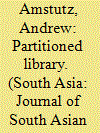

|
|
|
|
|
| Summary/Abstract |
This article argues that the history of a damaged Urdu library in Delhi reveals new perspectives on the ways in which prominent Indian Muslim scholars dealt with the violent displacements of the 1947 Partition of British India and imagined new futures for the Urdu language across the borders of India and Pakistan. The library of the Anjuman-e Taraqqi-e Urdu (Association for the Advancement of Urdu), an influential Urdu literary association, was damaged during the violence following Partition in August 1947. In contrast to the relative absence of official commemorations of Partition in post-colonial South Asia, the Anjuman’s leaders documented and publicised the violence of Partition on their library. Moreover, these Urdu scholars used the material process of restoring the damaged library in 1947 and 1948 to rethink the role of the library as a repository to preserve evidence of the continuing production of Urdu knowledge in India. In turn, the disputed division of the library in 1949 illuminates competing visions for Urdu’s future in India, Pakistan, and beyond. This story of one Urdu library demonstrates how changing library collecting priorities and material practices shaped broader debates over Urdu’s place in twentieth-century South Asia.
|
|
|
|
|
|
|
|
|
|
|
|
|
|
|
|
| 10 |
ID:
172225


|
|
|
|
|
| Summary/Abstract |
This article traces the fortunes of one of India’s great libraries, which Tipu Sultan of Mysore amassed largely through plunder and which the British East India Company plundered in turn. It shows how Tipu used the library to legitimise his authority and how rival factions of the Company, after defeating him in 1799, did the same. The article links the figuration of loot in the subcontinent, as studied by historians of material culture, to the conceptualisation of British India, as studied by historians of political thought. More broadly, it attests the symbolic power that plunder had—perhaps still has—to confer prestige.
|
|
|
|
|
|
|
|
|
|
|
|
|
|
|
|
| 11 |
ID:
172221


|
|
|
|
|
| Summary/Abstract |
We have heard and read much about the wartime bravery of Gurkha soldiers, the idea of the Gurkhas as a martial race and how British recruitment practices targeted them. But much less is known about the experiences of Gurkha prisoners of war in World War I. The Germans captured thousands of soldiers fighting in the British Indian Army, and among these were a large number of Gurkhas. This imprisonment of soldiers not only served German strategic goals, but also offered a good opportunity to collect source material for research. This paper will briefly shed light on the scholarly activities engaged in by German scholars in Halbmondlager (Half Moon Camp), with a focus on the self-referential writing of one of the Gurkha prisoners of war, Jas Bahadur Rai, who never returned from the camp, but who did bequeath to posterity a song which he sang for the Germans. We will discuss whether Jas Bahadur had freedom of agency while recording his song, and if this song indeed qualifies as life-writing.
|
|
|
|
|
|
|
|
|
|
|
|
|
|
|
|
|
|
|
|
|